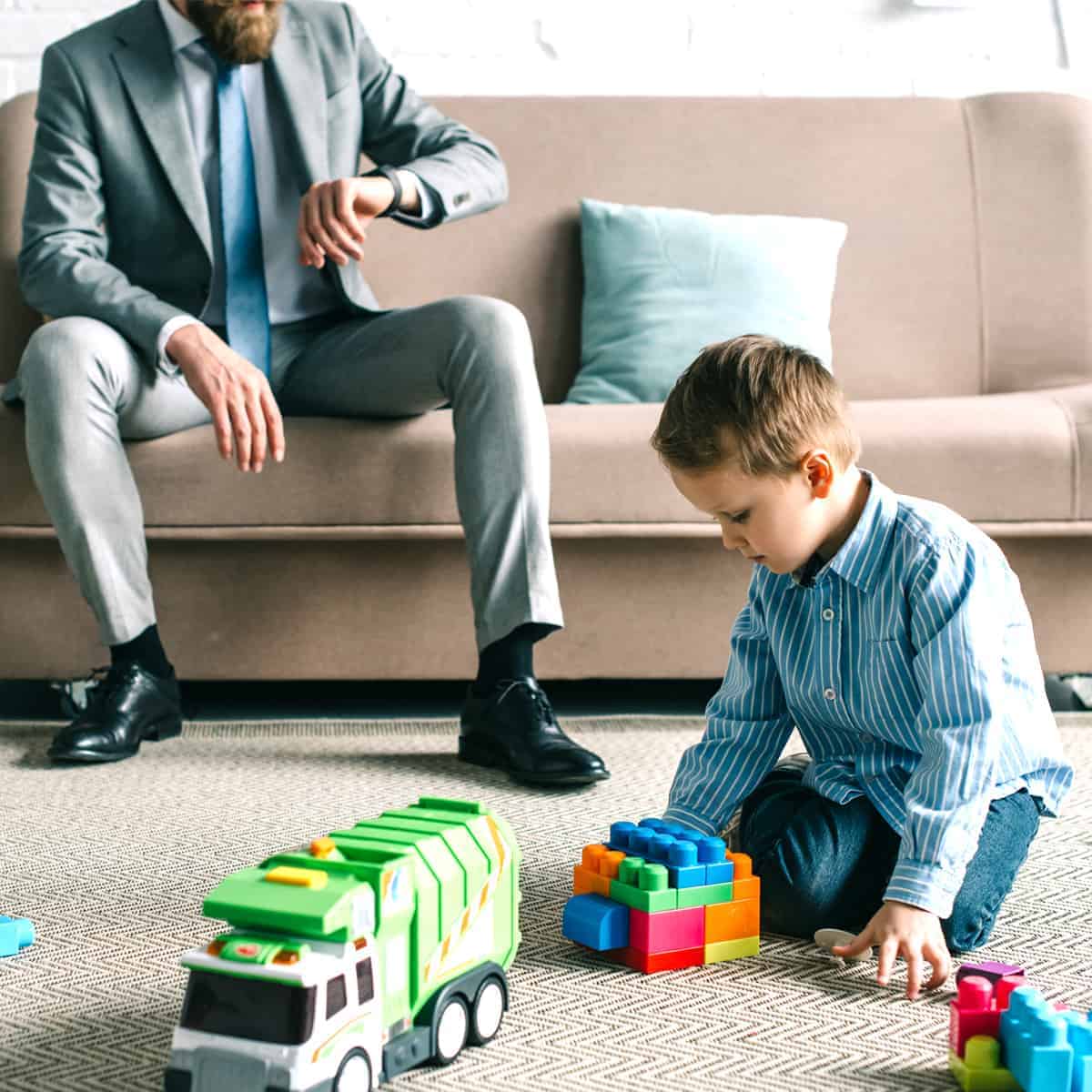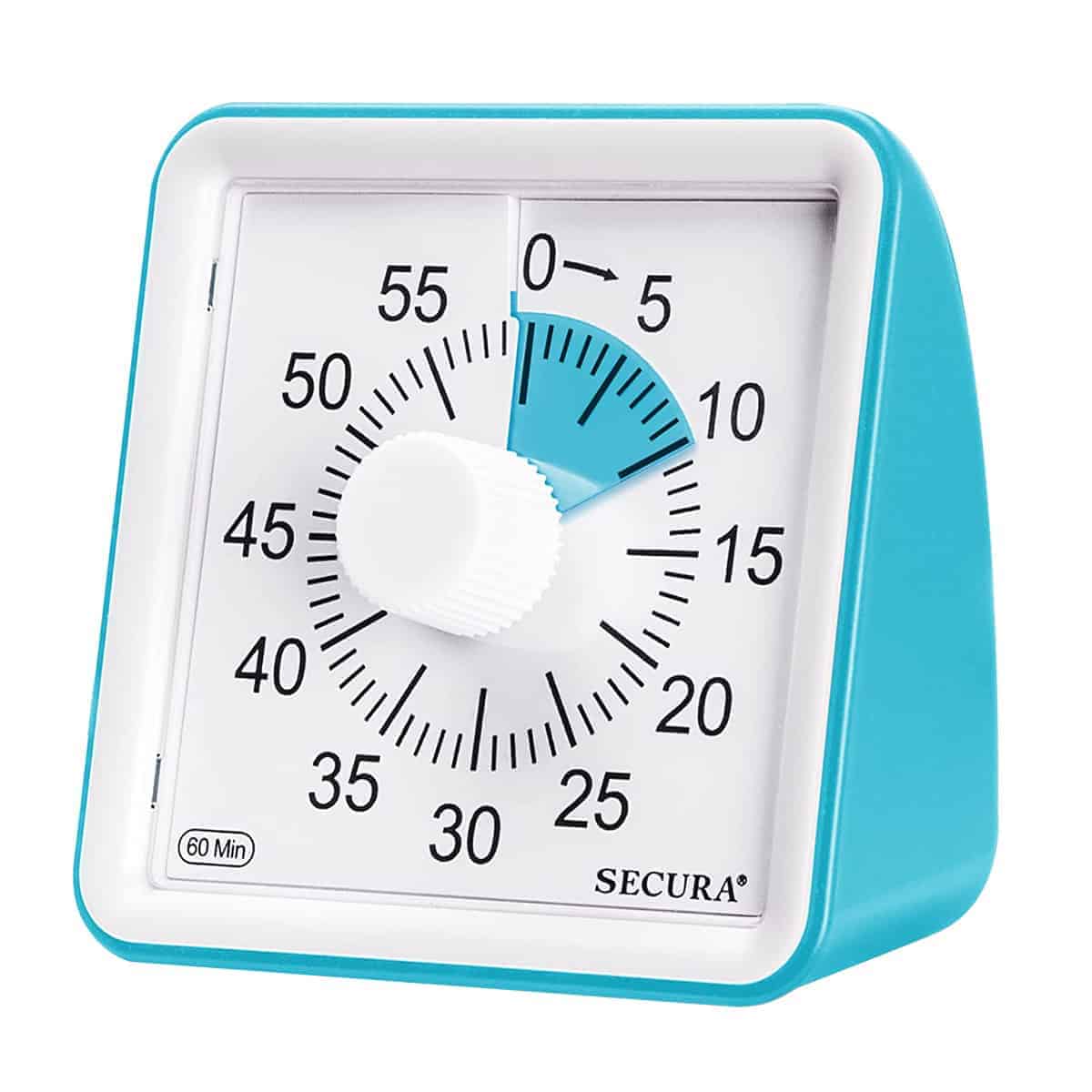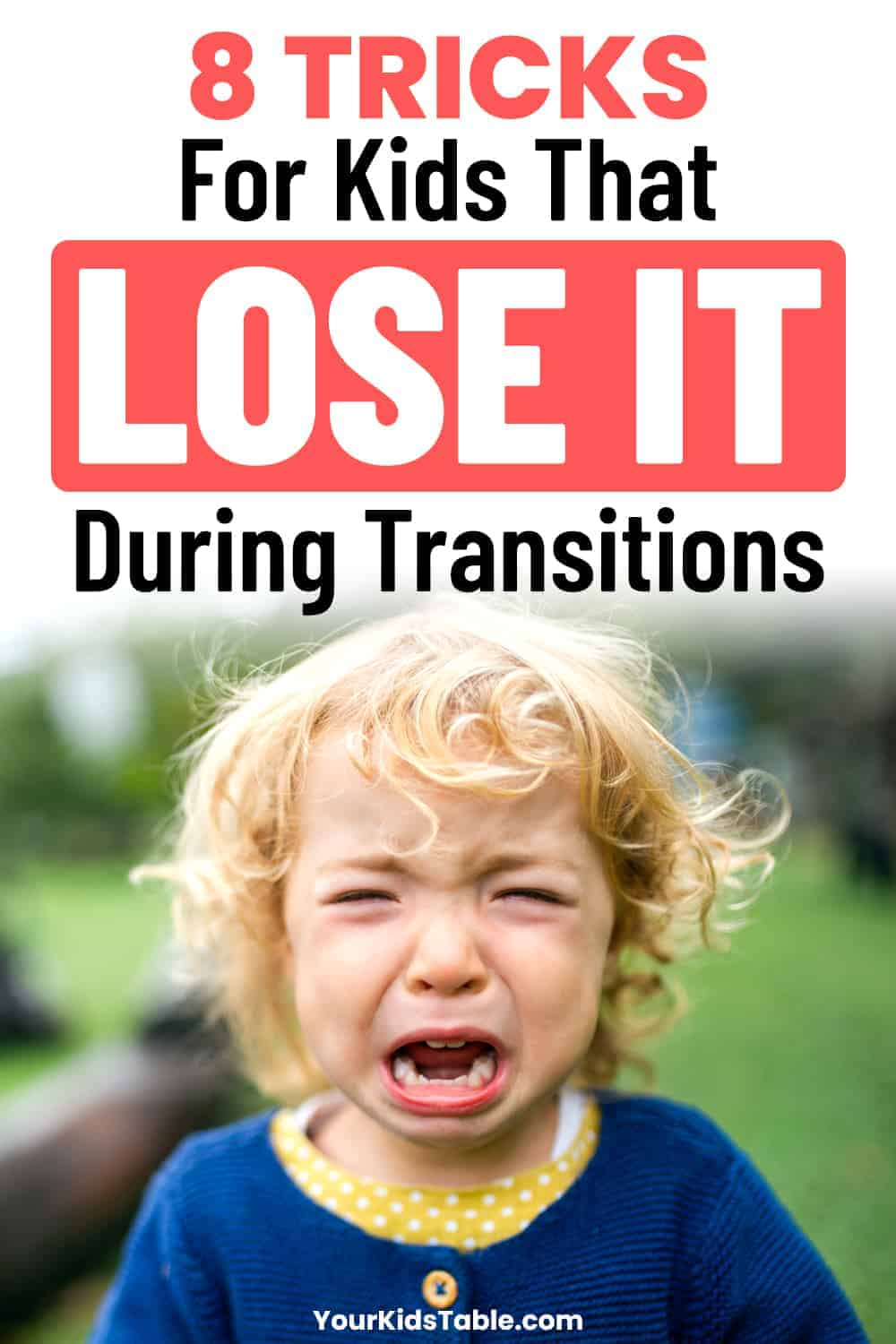Does your child need help with transitions? Learn 8 strategies and transition activities to lose the meltdowns and move from one activity to the next without a fight.
Affiliate links used below. See our full disclosure.
Change is hard.
Most people can agree that switching gears from one thing to the next can be challenging at times for a number of reasons.
Have you ever noticed that tension starts to rise the second you tell your kids, “5 more minutes and then it’s time to go”? Even if they were perfectly fine before, it’s like the warning that things are about to end sends them into a downward spiral.
While transitions happen every day, many kids struggle with them.
If you find yourself dreading daycare drop offs, the countdown to leave the park, or even just getting your kids dressed, they may be struggling with transitions.
But why are these things so hard, and more importantly, how and when do things get better?
What Are Transitions?
Transitions are simply a change in a routine or moving from one activity to the next.
They can be as small as starting playtime after lunch, or larger like school drop off.
Try counting all of the things you do from the moment you wake up until leaving the house, and you will see that our daily lives are made up of a hundred different transitions where we are finishing up one task and moving on to the next.
This process is especially hard for kids and can be a major source of stress, triggering tantrums, meltdowns and other unwanted behavior.
Transitions like getting ready for the day, taking a nap, or going to bed for the night are very common moments for kids to struggle.
Beyond these day-to-day transitions like morning routine and getting out the door, are life transitions that impact more than just that day.
Things like moving to a new home, the birth of a sibling, or starting preschool are much bigger transitions that can also have an equally large impact on toddlers and older children.
While there are different types of transitions, both small and large affect kids because they challenge areas of the brain that are undergoing great development in the early years of life.

Why Are Transitions Hard For Kids?
While it’s more common for kids with attention deficits, self-regulation difficulties, or cognitive delays to have problems transitioning, it is still a very common struggle for most kids at some point.
Because it’s so common, it might seem as if there’s also a simple explanation, but why transitions are hard for kids can actually be a number of reasons.
One big reason is control and your child’s natural instinct to exert ownership over their choices in life.
Every parent knows this one- the meltdowns over a color of cup, whether the banana was cut the “right way” or bedtime battles. You’d be hard pressed to find a child who hasn’t given a bit of pushback in this area, especially in the toddler years.
Nobody likes to feel micromanaged, and kids especially will look for any opportunity to be in control because so much of their life is decided by someone else.
This is a big reason why meltdowns can occur over seemingly miniscule things like the color of their cup.
Apart from wanting control, a less obvious factor in difficult transitions is the brain development required to understand how and why a transition is happening.
Basically, a child needs to have at least a general concept of time’s progression to be comfortable with transitions, and this is a very abstract concept to most kids.
They also need to have the self-regulation to understand “sometimes I have to stop doing something I like.” This can be really hard!
These skills are simply not developed in young children, and many older kids struggle with these higher-level thinking skills called executive function.
The time management, future thinking, and organizational skills required to understand transitions all fall under this category of skills. More on executive function skills by age here.
While control and under-developed executive function skills definitely contribute to difficult transitions, a less obvious but common reason is kids dealing with sensory sensitivities.
Current research actually shows us that there is a direct link between sensory processing and executive functioning in kids.
Kids who have difficulty with sensory processing typically thrive in routine and the predictability of schedule, and transitions work against their need for things to stay the same.
Sensory processing requires us to both perceive sensory input appropriately from our environment and then respond appropriately. Many kids struggle in one or both of these areas.
For example, a sensory avoidant kid might struggle with hating how their socks and shoes feel (perceiving their environment), by throwing a fit and avoiding getting dressed for the day (their response).
You can see how this might look like a run of the mill meltdown, but actually points to a bigger picture of sensory difficulties.
These sensory sensitivities often show up as poor attention, decreased listening or direction following skills, and even constant fidgeting and wiggling-all of which make transitioning tough.
Sensory processing is directly tied to our ability to self-regulate and respond to our environment appropriately, so it makes a lot of sense that this has a big impact on being able to move from one task to another.
Whatever is causing your child to struggle with transitions, understanding the why is a first step in helping smooth out the transition process.
Transition Activities to Help Your Child
If you’ve identified that stopping a task and starting a new one is hard for your kid, there is good news.
These 8 tips can make the change a bit easier to accept. I would encourage you to try out several of these and see what makes the biggest difference for your child.
Transition Activity #1: Use a visual schedule or make clear ahead of time what the plan is.
Having a visual cue or order of events for the day can take out the mystery of “what’s next” for your child. It can be as simple as a white board listing out the steps of morning routine, but many children find these very helpful.
Transition Activity #2: Provide a timer or countdown to warn your child of upcoming transition.
Again, you’re adding a tangible component to something abstract. Children LOVE visual timers. Here is one that I use all the time to show how much time is left.
A simple phone timer, or a countdown song works just as well.

Transition Activity #3: Keep transitions short and moving forward instead of dragging on.
Have you ever noticed that your kids can feed off of your energy? This goes for transitions, too. If you drag on the change, it alerts your kids that this might be a big deal, and they can respond with bigger pushback.
Instead of entering a negotiation that you didn’t sign up for, keep the transition short and sweet.
Stay calm and confident in the boundaries of the change and try to get from point A to B in the shortest way possible.
It can also really help to have things ready ahead of time. Running the bath, or having clothing already set out before you signal the transition can go a long way.
Transition Activity #4: Be silly and make it fun. Try “being an animal,” playing a song, or walking backwards to the next activity.
This is a tried and true one from my occupational therapy bag of tricks that also works great for my own kids. There is a lot of power in being silly and using movement when it comes to all kinds of kid issues.
Instead of saying “it’s time for a nap,” try “flying like a bird” to their bedroom.
Remember that sensory link?
Getting your child to move their body in a coordinated way with animal walks gives them calming sensory input that helps them focus, re-direct, and activates their proprioceptive system– all of which can really help when it comes time to switch gears to a new task.
Adding a song on top of the movement is even better. Now you have a movement sensory component AND an auditory one!
There is also a reason preschool classrooms use movements and songs for tasks like “clean up” and “goodbye” and that’s because they work!
Transition Activity #5: Take a break between activities. Doing jumping jacks, having a snack, or a quick drink of water can redirect to the next activity.
This one may take a little preparation, but can really help, especially if your child melts down when it’s time to switch gears.
If you know you have a day of errands ahead of you, maybe stop at a park for a quick run around to reset things.
I know I’m sounding like a broken record here, but movement is a HUGE way for many kids to focus, pay attention and accept change when it’s time to transition.
And, the movement can be simple.
Strategically place snacks, movement activities, and sensory play between tasks to break things up a bit.
Encouraging your child to regularly participate in sensory play throughout the day is a great way to not only build their sensory processing skills, but also build some routine and predictability into the otherwise unpredictable moments for your child.
Check out our list of sensory toys for ideas to help add these into your routine.
Transition Activity #6: Practice! Make transitioning part of the daily routine to familiarize the process.
Kids thrive on routines and predictability. It is why they struggle with transition in the first place.
Start making your transitions, the schedule you use, the songs, and the change part of every day and your kid is much more likely to accept it.
Transition Activity #7: Offer choices in order of transitions, or between 2 options to give your child some power.
A little bit of power goes a long way, and sometimes having freedom within the boundary of transition does the trick.
If you know you need to get out the door to school, offer as much independence within that activity as possible.
Maybe your child can pick the order of getting dressed, breakfast, and picking a song for the car ride.
This is a classic “don’t fight every battle you are presented with” situation, and it can save you a meltdown when put into practice.
Transition Activity #8: Use a transition object or toy.
Try having a novel item that you use specifically for transitions. It could be a stuffed animal, a sticker, maybe a special song you sing when it’s time to wrap things up.
In my house, we use a concept called “the magic spot.” We change it up every once in a while- it can be the bottom step, a certain rug, maybe even the front door.
When it’s time to leave, I say, “we are leaving, I want everyone to head to the magic spot to show me you’re ready!” It sounds silly (and it is) but there is something about racing to the “right” spot that adds some fun into the transition.
Maybe the first person who gets to the car gets to control the music? Whatever it is, make transitioning exciting in some way.

Transitions in the Classroom
If you’re a teacher, or your child is school-aged, chances are you are looking for ways to help kids transition in the classroom.
School days are full of them, whether it be moving from class to class or from recess back inside after lunch. And many kids struggle with these transitions even more than they would in the home environment for a number of reasons.
Heightened emotions, changes in activity levels (like no outdoor recess on a cold day), or the number of people around can all impact how a child responds to their environment.
Having a sensory corner in your classroom is a great start to allowing kids to engage in purposeful sensory play at strategic times of day and can bring back calm and focus for transitions to your day.
A bit of observation of your kids who struggle with transitions may show you areas that you can include simple sensory strategies to help move your day forward.
For example, students who struggle to keep their hands to themselves in line might benefit from a minute or two of deep pressure with a weighted blanket to self-regulate before standing in line.
A child who has trouble sitting still at their desks after recess may respond well to a fidget at their desk while they listen to instructions for their assignment.
And even using those same movement strategies to move from activity to activity in your classroom can give kids just enough input to redirect and focus for the next task.
Visual timers, schedules, transitional objects, and songs can all be very effective for students in the school setting.
Using these sensory strategies not only for the kids who struggle, but the whole class, can make all the difference in the classroom.
There you have it! While I wish the process of smooth transitions could happen overnight, it is likely that several of these strategies will have to come together with some practice to see improvements.
But your kids might surprise you! Let us know in the comments what your favorite transition technique is!
To learn more about supporting your child’s sensory challenges, like difficulty transitioning, check our free sensory workshop!
Click here to sign up for FREE!
Did You Pin This?
Laura Mau is a licensed occupational therapist and member of the Your Kid’s Table team. She has over 8 years of clinical experience in helping families navigate complex feeding and eating, sensory processing, and reaching developmental milestones with their children. She currently practices in Colorado and has 2 young kids of her own.
Alisha Grogan is a licensed occupational therapist and founder of Your Kid’s Table. She has over 18 years experience with expertise in sensory processing and feeding development in babies, toddlers, and children. Alisha also has 3 boys of her own at home. Learn more about her here.

Hi Alistair, my DS son Nathan with mild autism, has stopped going to school because of some sensory issues there. I think the teacher shouting at him. I am trying hard to convince him. It is 3 months now. He is going to be 16 on 20 th feb, but is not interested even in celebrating his birthday in school. He is not missing friends there. Please give me some ideas that will work for him.
Hi Alisha! I have been following you for a little while now and have taken a couple of your courses. As an OT, I like to keep myself in check by researching what other therapists are doing and comparing to what I do and how I do it. You do such a great job educating others and I find that my way of work greatly aligns with yours. I work as a school-based practitioner (in my 15th year now in schools and 28 years total!) and I have been creating informative flyers to send home to parents of my pre-K and VPK students. I love this post and use all the strategies you have listed. I am hoping you won’t mind if I use some of the information from this post in one of my flyers with proper credit. I love how concise your 8 tips are and it has given me the inspiration to address this very important topic in one of my flyers! Thank you and keep up the good work!
Hi Carrie! Absolutely you can! Thanks for asking and thank you for sharing! We’re so happy to hear you enjoy our content and find it helpful 🙂
Best,
Kalyn